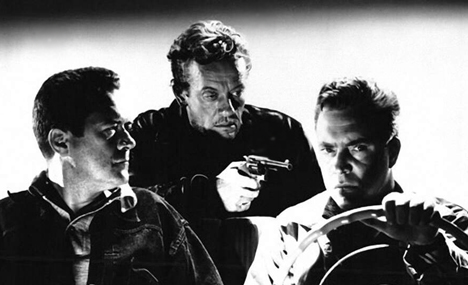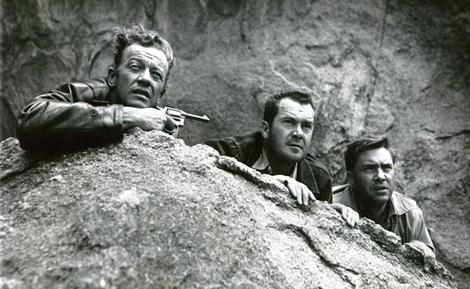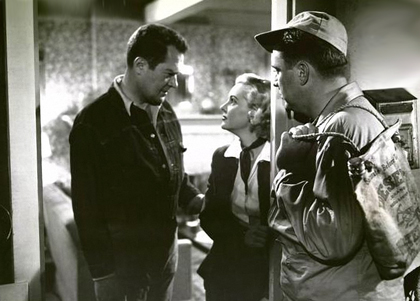Reviewed by Glenn Erickson
Independent Hollywood moviemaking got off to a fitful start in the late 1940s when name talent, influential producers and known directors banded together to package movie projects for sale to the majors. With economic forces making studio-based production more and more expensive, even the moguls could see the benefit in 'picking up' a few outside films for the release schedule. In a few years complete unknowns with a minimum of financial backing would have a chance to break in, and the careers of Stanley Kubrick, Roger Corman and Herman Cohen would be launched. But the pros aimed a little higher. United Artists developed a relationship with Arnold Laven, Jules V. Levy and Arthur Gardner, starting with a modest crime film, Without Warning! Radio notable Arch Oboler also turned to independent filmmaking, and launched the first 3-D craze with his safari opus Bwana Devil.
Another studio making deals with wildcat independents at that time was RKO. Its new owner Howard Hughes had practically shut down the Hollywood lot. He was still making a few pictures a year but seemingly kept as many on the shelf, either half-forgotten or waiting for his personal attention. To bridge the gap Hughes resorted to importing foreign pictures and having his short subject unit make ultra-cheap features, such as 1950's The Tattooed Stranger.
The ambitious actress Ida Lupino formed a partnership with her writer/producer husband Collier Young called The Filmmakers, for the express purpose of selling projects to Howard Hughes. Lupino was a glamorous movie star but also a tough-minded show-business professional known for getting her way on the set. The partnership (and marriage) lasted long enough to establish Lupino as a working director in Hollywood's closed shop of the 1950s. She was the first woman since Dorothy Arzner to achieve that status. Hughes trusted her to reshoot the ending of Nicholas Ray's On Dangerous Ground and kept The Filmmakers going for four or five pictures.

Lupino's last show for RKO, and perhaps her best-directed movie, is 1953's The Hitch-Hiker. The grim suspense thriller is filmed on a tiny scale but yields a surfeit of tension; it is also noted as the only classic-era film noir directed by a woman.
Almost all of The Hitch-Hiker takes place in a car driven by mechanic Roy Collins (Edmond O'Brien and draftsman Gil Bowen (Frank Lovejoy), pals on their way to Mexico for a weekend of fishing. The lone hitchhiker they pick up on the desert road turns out to be serial killer Emmett Myers (William Talman), a cunning psychopath who has been roaming the country murdering people and taking their cars. The deranged Myers bullies the men at gunpoint and derides them as foolish weaklings. He makes it clear that his intention is to murder them both. Collins and Bowen can see no avenue of escape, and look for ways to get a signal out. They know that Myers will kill them the moment the authorities realize they're his prisoners, so they try to put the car radio out of action. But none of their plans seem to work. They drive hundreds of miles into Baja California so that their captor can catch a ferry to the Mexican mainland. Myers won't let Gil talk to the locals in Spanish. He's almost killed them at several junctures -- how can they possibly survive?

The Hitch-Hiker abandons the romantic noir notions of the earlier decade to tell the story of a particularly heinous true-life crime. Its ruthless game of survival is distinguishable from straight thriller fare like John Sturges' Jeopardy (also 1953), which remains essentially sentimental in outlook. The twisted Emmett Myers seems less a man than a symbol of '50s anxieties. Myers visits chaos on peaceful lives, choosing his victims at random and striking out of the blue. Gil and Roy are vaguely unsatisfied with their secure but dull lives, and the grumble about escaping from responsibility. They joke about the availability of women in Mexico, a hint that their getaway weekends might not be as innocent as we think. Jus the same, their harrowing survival ordeal seems a disproportionate punishment for their sin of complacency.
Adding a macabre touch to the weirdness is Myers' malformed eyelid, which does not close. Roy and Gil cannot sneak away at night, because it's impossible to tell when their tormentor is actually sleeping. William Talman specialized in highly credible cold-blooded noir villains -- Armored Car Robbery, The Racket, City that Never Sleeps -- but Emmett Myers is his most disturbing characterization. The maniac survives by sticking to an utterly heartless M.O.: leave no living witnesses. The sight of his staring lame eye adds a touch of Edgar Allan Poe's The Tell-Tale Heart.

Edmond O'Brien and Frank Lovejoy are part of the new breed of '50s noir actors, non-heroic everymen unequipped with ju-jitsu moves or intimidating charm. They become immediate identification figures, helping each other to maintain composure under the threats and taunts of the reptilian Myers. Out of options and realizing that he may never see his wife again, Gil leaves his wedding ring behind at a gasoline stop. What are the chances that somebody will do more than just pocket the ring? It's an all but hopeless gesture.
Ida Lupino's movie benefits from the cinematography of noir ace Nicholas Musuraca, who manages to light convincing desert night scenes, and saves his fancy shadow lighting for the exciting conclusion on a Mexican wharf. As expected, quite a bit of the film was shot on a process stage with rear projected roadway views. Many exteriors are second unit work, further trimming days in which a full crew was needed. Unlike some of RKO's earlier noir adventures in Mexico, such as the Robert Mitchum/Jane Greer adventure The Big Steal, no foreign locations were used. But The Hitch-Hiker maintains Howard Hughes' policy of treating Mexican characters and particularly their police force with full respect. José Torvay's highway patrolman is a sharp cookie hot on the kidnapper's trail. In real life, an alert Mexican cop was the one to nab the armed & dangerous killer.

Stills exist of a deleted scene showing the vacationers saying goodbye to Gil's wife (above). The only scenes away from the kidnap car show some rather idealized U.S. and Mexican lawmen strategizing to protect Roy and Gil by issuing false radio announcements to make Myers think they've lost the scent. The much imitated The Hitch-Hiker remains a gripping suspense ordeal.
Ida Lupino and Collier Young wrote the final screenplay, but the original story for The Hitch-Hiker was by Daniel Mainwaring, who as Geoffrey Homes wrote the sublime RKO noir Out of the Past. Howard Hughes refused to allow Mainwearing's name to appear: "We are going to screen everyone in a creative or executive capacity. It is my determination to make RKO one studio where the work of Communist sympathizers will not be used". It was reported that Hughes once issued instructions for the title sequences of a number of RKO pictures to be re-shot, to purge the names of accused disloyal talent. The order was never carried out.

Kino Classics' Blu-ray of The Hitch-Hiker is an acceptably handsome encoding that far surpasses the quality of earlier gray-market tapes and discs. Kino sourced its transfer from "archival elements preserved by the Library of Congress", and viewers get the benefit of improved contrast and sharpness, with the trade off of some scratches here and there.. Nicholas Musuraca's fine camerawork can finally be appreciated. The only extra is a selection of still and artwork images. The arresting package art comes from the film's original, effective ad campaign.
Bret Wood's liner notes point to The Hitch-Hiker being inspired by the true-life case of Billy Cook, a pre- Charles Starkweather serial killer who indeed had a deformed right eyelid. Cook's multi-state crime spree also ended in Mexico. His last words were, "I hate everybody's guts, and everybody hates mine."
On a scale of Excellent, Good, Fair, and Poor,
The Hitch-Hiker Blu-ray rates:
Movie: Excellent
Video: Good with some damage
Sound: Very Good
Supplements: still gallery
Deaf and Hearing Impaired Friendly?
N0; Subtitles: None
Packaging: Keep case
Reviewed: October 29, 2013
Republished by permission of Turner Classic Movies.

DVD Savant Text © Copyright 2013 Glenn Erickson
See more exclusive reviews on the Savant Main Page.
Reviews on the Savant main site have additional credits information and are often updated and annotated with reader input and graphics.
Also, don't forget the
2011 Savant Wish List.
T'was Ever Thus.
Return to Top of Page
|

